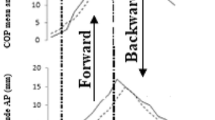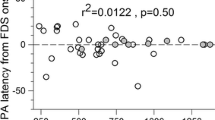Abstract
We investigated the speed–accuracy trade-off in a task of pointing with the big toe of the right foot by a standing person that was designed to accentuate the importance of postural adjustments. This was done to test two hypotheses: (1) movement time during foot pointing will scale linearly with ID during target width changes, but the scaling will differ across movement distances; and (2) variations in movement time will be reflected in postural preparations to foot motion. Ten healthy adults stood on the force plate and were instructed to point with the big toe of the right foot at a target (with widths varying from 2 to 10 cm) placed on the floor in front of the subject at a distance varying from 10 to 100 cm. The instruction given to the subjects was typical for Fitts’ paradigm: “be as fast and as accurate as possible in your pointing movement”. The results have shown that movement time during foot pointing movements scaled with both target distance (D) and target width (W), but the two dependences could not be reduced to a single function of W/D, confirming the first hypothesis. With respect to the second hypothesis, we found that changes in task parameters led to proportional variations in movement speed and indices of variability of the postural adjustments prior to leg movement initiation, confirming the second hypothesis. Both groups of observations were valid over the whole range of distances despite the switch of the movement strategy in the middle of this range. We conclude that the speed–accuracy trade-off in a task with postural adjustments originates at the level of movement planning. The different dependences of movement time on D and W may be related to spontaneous postural sway (migration of the point of application of the resultant force acting on the body of the standing person). The results may have practical implications for posture and gait rehabilitation techniques that use modifications of stepping accuracy.







Similar content being viewed by others
References
Aruin AS, Latash ML (1995) Directional specificity of postural muscles in feed-forward postural reactions during fast voluntary arm movements. Exp Brain Res 103:323–332
Belen’kii VE, Gurfinkel VS, Pal’tsev EI (1967) Control elements of voluntary movements. Biofizika 12:135–141
Bouisset S, Zattara M (1987) Biomechanical study of the programming of anticipatory postural adjustments associated with voluntary movement. J Biomech 20:735–742
Brunt D, Lafferty MJ, McKeon A, Goode B, Mulhausen C, Polk P (1991) Invariant characteristics of gait initiation. Am J Phys Med Rehabil 70:206–212
Brunt D, Liu SM, Trimble M, Bauer J, Short M (1999) Principles underlying the organization of movement initiation from quiet stance. Gait Posture 10:121–128
Brunt D, Short M, Trimble M, Liu SM (2000) Control strategies for initiation of human gait are influenced by accuracy constraints. Neurosci Lett 285:228–230
Cordo PJ, Nashner LM (1982) Properties of postural adjustments associated with rapid arm movements. J Neurophysiol 47:287–302
Crossman ER, Goodeve PJ (1983) Feedback control of hand-movement and Fitts’ Law. Q J Exp Psychol A 35(Pt 2):251–278
Danion F, Duarte M, Grosjean M (1999) Fitts’ law in human standing: the effect of scaling. Neurosci Lett 277:131–133
Duarte M, Freitas SM (2005) Speed–accuracy trade-off in voluntary postural movements. Motor Control 9:180–196
Fitts PM (1954) The information capacity of the human motor system in controlling the amplitude of movement. J Exp Psychol 47:381–391
Fitts PM, Radford BK (1966) Information capacity of discrete motor responses under different cognitive sets. J Exp Psychol 71:475–482
Freitas SM, Duarte M, Latash ML (2006) Two kinematic synergies in voluntary whole-body movements during standing. J Neurophysiol 95:636–645
Gravelle DC, Laughton CA, Dhruv NT, Katdare KD, Niemi JB, Lipsitz LA, Collins JJ (2002) Noise-enhanced balance control in older adults. Neuroreport 13:1853–1856
Gutman SR, Latash ML, Almeida GL, Gottlieb GL (1993) Kinematic description of variability of fast movements: analytical and experimental approaches. Biol Cybern 69:485–492
Hasan Z, Karst GM (1989) Muscle activity for initiation of planar, two-joint arm movements in different directions. Exp Brain Res 76:651–655
Ito T, Azuma T, Yamashita N (2003) Anticipatory control in the initiation of a single step under biomechanical constraints in humans. Neurosci Lett 352:207–210
Klapp ST (1975) Feedback versus motor programming in the control of aimed movements. J Exp Psychol Hum Percept Perform 104:161–169
Koshland GF, Hasan Z, Gerilovsky L (1991) Activity of wrist muscles elicited during imposed or voluntary movements about the elbow joint. J Mot Behav 23:91–100
Latash ML, Gutman SR (1993) Variability of fast single-joint movements and the equilibrium-point hypothesis. In: Newell KM, Corcos DM (eds) Variability in motor control. Human Kinetics, Urbana, pp 157–182
Latash ML, Aruin AS, Shapiro MB (1995) The relation between posture and movement: a study of a simple synergy in a two-joint task. Hum Mov Sci 14:79–107
Lee WA, Michaels CF, Pai YC (1990) The organization of torque and EMG activity during bilateral handle pulls by standing humans. Exp Brain Res 82:304–314
Massion J (1992) Movement, posture and equilibrium: interaction and coordination. Prog Neurobiol 38:35–56
Meyer DE, Abrams RA, Kornblum S, Wright CE, Smith JE (1988a) Optimality in human motor performance: ideal control of rapid aimed movements. Psychol Rev 95:340–370
Meyer DE, Irwin DE, Osman AM, Kounios J (1988b) The dynamics of cognition and action: mental processes inferred from speed–accuracy decomposition. Psychol Rev 95:183–237
Mohagheghi AA, Anson JG (2001) Interactions among end-effectors and movement parameters influence reaction time in discrete, rapid aimed movements. Hum Mov Sci 20:603–641
Plamondon R, Alimi AM (1997) Speed/accuracy trade-offs in target-directed movements. Behav Brain Sci 20:279–349
Rogers MW, Pai YC (1990) Dynamic transitions in stance support accompanying leg flexion movements in man. Exp Brain Res 81:398–402
Rogers MW, Pai YC (1995) Organization of preparatory postural responses for the initiation of lateral body motion during goal directed leg movements. Neurosci Lett 187:99–102
Rogers ME, Rogers NL, Takeshima N, Islam MM (2003) Methods to assess and improve the physical parameters associated with fall risk in older adults. Prev Med 36:255–264
Schmidt RA, Zelaznik H, Hawkins B, Frank JS, Quinn JT Jr (1979) Motor-output variability: a theory for the accuracy of rapid motor acts. Psychol Rev 47:415–451
Shumway-Cook A, Woollacott MH (2001) Motor control: theory and practical applications. Lippincott Williams & Wilkins, Philadelphia
Winter DA (1991) The biomechanics and motor control of human gait: normal, elderly and pathological. University of Waterloo Press, Waterloo, ON
Acknowledgments
This work was supported by a FAPESP/Brazil grant (04/10917-0) to M. Duarte and by an NIH grant (NS-035032) to M. Latash. The authors are thankful to Siripan Siwasakunrat and Yun Wang for their help in the data collection.
Author information
Authors and Affiliations
Corresponding author
Rights and permissions
About this article
Cite this article
Duarte, M., Latash, M.L. Effects of postural task requirements on the speed–accuracy trade-off. Exp Brain Res 180, 457–467 (2007). https://doi.org/10.1007/s00221-007-0871-x
Received:
Accepted:
Published:
Issue Date:
DOI: https://doi.org/10.1007/s00221-007-0871-x




